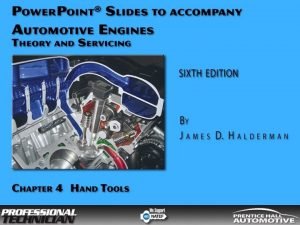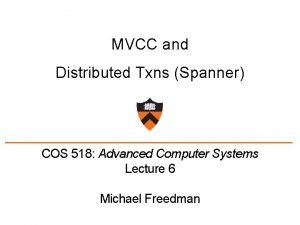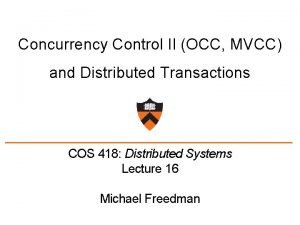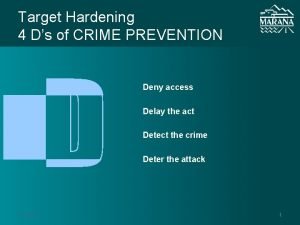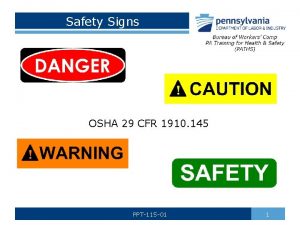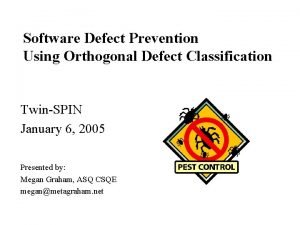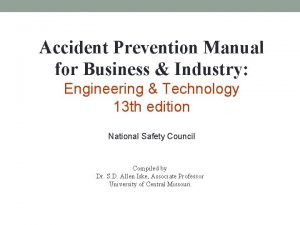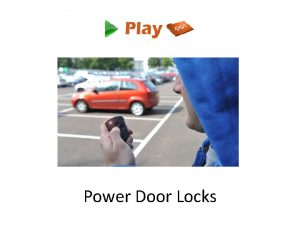Crime Prevention Part I Locks Texas Crime Prevention


































































































- Slides: 98

Crime Prevention Part I: Locks Texas Crime Prevention Association www. TCPA. org

Learning Objectives The student will be able to identify the operational functions of a lock cylinder, to include terms: standard key, master key and grand master key. The student will be able to identify the differences between privacy locks and security locks. The student will be able to identify single cylinder deadbolt locking devices and the level of security they provide. The student will be able to identify double cylinder deadbolt locking devices and the level of security they provide. The student will be able to identify night latches locking devices and the level of security they provides. The student will be able to identify a push button combination locks locking devices and the level of security they provide.

Learning Objectives The student will be able to identify commercial locks locking devices and the level of security they provide. The student will be able to identify card reader locking devices and the level of security they provide. The student will be able to identify a thumb print reader locking devices and the level of security they provide. The student will be able to identify the minimum specifications for a high-security deadbolt. The student will be able to identify supporting hardware that adds to the security of an entry; cylinder guards and jimmy guards

Learning Objectives The student will be able to identify a mortise lock and the level of security it provides. The student will be able to identify a rim-mounted lock and the level of security it provides. The student will be able to identify a tubular lock and the level of security it provides. The student will be able to identify a cylindrical lock set and the level of security it provides. The student will be able to identify a unit lock and the level of security it provides.

Learning Objectives Learning Objective: The student will be able to identify the minimum specifications for a good security padlock. The student will be able to identify the basic function of a padlock and its application. The student will be able to identify hasp, chain, cable and locking bar that are used in conjunction with padlocks. The student will be able to identify the types of padlocks and the level of security provided by each. The student will be able to identify the minimum specifications for a good security padlock. The student will be able to identify the basic function of a padlock and its application.

Learning Objectives The student will be able to identify hasp, chain, cable and locking bar that are used in conjunction with padlocks. The student will be able to identify auxiliary locking devices for sliding glass doors and windows.

Lock History 101 Man’s first “lock” may have been nothing more than a large rock rolled against the mouth of his cave to keep out prowling animals. As civilization developed however, a variety of means were devised to provide security. One common method was beam fixed across a door and frame to prevent the door from being pushed open.

Lock History 101 Egyptian pin tumbler locks were probably the first designed to allow doors to be unlocked from the outside. These locks were wooden and utilized wooden keys that operated the primitive tumbler mechanism.

Lock History 101 The Greeks employed locks that used keys. This system was a lock and bar arrangement where a large bar or bolt was fastened on the inside of the door. To open the door, the Greeks fashioned a key shaped like a “sickle” that was inserted through holes in the door. When turned, the tip of this key device would lift up the bar or bolt. The disadvantage of this system was that the keys were as much as three feet in length and were, therefore, somewhat inconvenient to carry.

Lock History 101 • It was not until the 18 th century that real improvements were made in the technical operation of locks. At that time, lever tumbler locks of basically sounds construction were developed. • Improvements continued slowly until the 19 th century when public demand produced major breakthroughs.

Lock History 101 - continued Linus Yale revolutionized the lock industry when he invented the modern pin tumbler lock. This device had three major advantages over other locking systems: ØIt could be mass produced. ØThe key mechanism or pin tumbler cylinder was separate from the bolt. ØLong, heavy keys were not needed to reach and manipulate the bolt.

Lock History 101 A lock acts to temporarily fasten two separate objects together, such as a door to its frame or a lid to a container. The objects are held together until the position of the internal structure of the lock is altered, for example by a key, so that the objects are released.

Patchwork Security CRIME Prevention has been waiting for the architectural fraternity and the door and door frame manufacturers to provide substantial basis for security hardware.

Patchwork Security Many sound locks are available, however the security value of these locks are often negated by weak doors or door frames. Always check with your local safety codes as some locks are prohibited!

Patchwork Safety Law Enforcement can help: Maintaining a close association with locksmiths is highly recommended. Documenting the “Modus Operandi” of burglars. Encouraging the application of meaningful methods of improving security on existing buildings.

Objective Our objective is to prevent the defeat of locks through force. When force is applied to a door in the form of a human body, pry bar, or jack, something gives. Every mechanical device has its fatigue and breaking point although no one, to our knowledge, specifically defines this “point” for doors, locks, and frames in terms of pounds of pressure or force.

Lock Definition A lock: Is a mechanical, hydraulic, or electronic device designed to prevent entry to a building, room, container, or hiding place Prevents removal of items without the consent of the owner.

Lock Definition A lock: Fastens two separate objects together, such as a door to its frame. The objects are held together until the position of the internal structure of the lock is altered by a key so that the objects are released.

Key Operated Mechanisms Uses arrangement of internal physical barriers (wards, tumblers) to prevent lock from operating unless they are properly aligned. A key is a device used to align internal barriers – lock operation


3 -Types of Key operated locks Disc or wafer tumbler Pin tumbler Lever

Tumbler Mechanisms Any lock mechanism having moveable, variable elements (tumblers) which depend on a key to arrange tumblers in straight line, permitting the lock to open. Tumbler lock element - security against improper key manipulation

Tumbler Mechanisms The tumbler, the actual lock barrier, may be a disc, lever or pin. Key has a particular combination of cuts which match the arrangement of the tumblers in the lock.


Disc or Wafer Tumbler Consist of three separate parts: Ø Ø Ø Keys Cylinder Plug Cylinder Shell (Housing) The cylinder plug contains the tumblers: spring loaded flat plates Key slots cut into each tumbler


Disc or Wafer Tumbler When no key is inserted or improper key used: One or more tumblers will extend through the sides of the plug into the top or bottom locking groves, cut into the cylinder shell. Firmly locking the plug to the shell.


Pin Tumbler Mechanism Most common type of key-operated mechanism used in door hardware design. Operated like disc tumbler mechanism. Uses pins as interior barrier verses disc.


Pin Tumbler Mechanism Proper key has cuts to match the length of the lower pins. When inserted, the tops of the key pins align flush with the top of the cylinder plug at the shear line. The plug is rotated to lock or unlock.

Pin Tumbler Mechanism When the key is withdrawn, drivers are pushed by springs into the cylinder – pushing the key pins ahead of them and seating them at bottom of the pin chamber. Drivers extend into the plug to prevent it from rotating.


Lever Tumbler Mechanisms Simialr principle as pin & disc tumbler design, with some differences. Lever lock does not use rotating core or plug. The bolt is the integral part – thrown directly by the key.

Lever Tumbler Mechanisms Each lever is hinged on one or more sides by the post; a fixed part of the case. Leaf springs attached to levers, hold them down in position overlapping the bolt notch, preventing the bolt from moving back.

Lever Tumbler Mechanisms The bolt is prevented from moving back by a “Fence” which is trapped by the front edges (shoulders) of the lever. When a key is inserted and slightly rotated the cuts on the key engage the saddle of lever, raising it to a position where the fence aligns with the slot in the lever (called the gate), causing the bolt to retract.

Combination Locks Works much the same way as a lever mechanism. When the tumblers align, the slots in the tumblers permit a fence to retract, which releases the bolt allowing it to be opened.

FENCE

Combination Locks Tumblers are called wheels Each wheel has a slot milled into its edge – designed to engage the fence when the slot is properly aligned. Slot is called a “Gate”

Combination Locks The fence is part of the lever which retracts the bolt. Gates are aligned with the fence by numbers or letters on the dial. The sequence of numbers/letters that allows the lock to operate is known as the “Combination”.

5 -Types of Locks Mortise Rim-mounted Tubular Cylindrical Lockset Unit Locks

Mortise Standard door lock is the most common on standard houses.

Types of Doors Mortise lock for aluminum door

Types of Sliding Glass Door Locks

Types of Sliding Glass Door Locks Glass door lock with alarm

Types of Sliding Glass Doors Insulated Glass Ø Ø Ø A combination of two or more panes of glass with a hermetically sealed air space between them. Some patio doors come standard with Sun. Coat® Low-E coating for added energy efficiency year-round. Optional argon gas may be used between panes, improving thermal performance and energy savings.

Sliding Glass Doors Head Ø The main horizontal member which forms the top of the sliding door frame. Sill Ø The main horizontal member forming the bottom of the sliding door frame.

Rim-Mounted Installed on surface rim of a door.

Tubular Sometimes called a bore-in, simply drill a hole into the door to accommodate the cylinder.

Cylindrical Lockset Uses a locking latch as a sole fastening element.


Unit Locks U-shaped cut on door edge, slipping lock into (over) cut out. No exposed screws and is used in lieu of a mortise lock where the door is too narrow.

Locking Devices Lock cylinders are manufactured in many styles and for many different purposes. Some lock cylinders are designed to operate with one key; some require a standard key or a master key; and others are designed to use the standard key, master key, or a grand master key.

These master pins allow a second key or master key to operate the lock.

Locks Some cylinder designs use three keys already mentioned, and have cores removable with a change key. Uses lock screws – Auxiliary locking device

Locks An auxiliary locking device must include: Screws Wooden dowels Pinning device Be key-operated

Dead Bolts A dead bolt lock must lock with a minimum bolt throw of 1” that penetrates a metal strike plate. It locks into place with no spring to extend or retract it.

Cylinder Dead Bolt One (1) i thro nch w

Dead Bolts If a door is secured by a deadbolt lock and has breakable glass within 40”, the lock must be key-operated from both sides unless prohibited by life safety codes.

Deadbolts Square face solid bolt, which is not spring loaded and must be turned by hand into either the locked or unlocked position. When incorporated into a locking mechanism, result is known as deadlock. Long-throw 1 -inch or longer bolt provides protection against door jam spreading.

Types of Sliding Glass Door Auxiliary Locks

Locks In areas in which life safety codes permit the use of metal bars or grating. They should be mounted to prevent easy removal and may be substituted for auxiliary locks.

Single Cylinder Deadbolt The single cylinder deadbolt is locked or unlocked from the outside by a key and from the inside with a thumb turn. The deadbolt automatically deadlocks. When it is fully extended, the bolt should have a minimum one-inch throw for security.

Single Cylinder Deadbolt Automatically deadlocks when it is fully extended.

Double Cylinder Deadbolt (Surface Mounted, Vertical Throw) • The double cylinder deadbolt is locked or unlocked by a key from either side. • The pressure cast bolts, with hardened steel inserts, have a vertical movement to resist prying the lock away from the strike. • Contains free wheeling cylinder guard.

Key Retention Key retention: prevents removing key from cylinder unless the key is in key way.

Double Cylinder Deadbolt

Surface Mounted Single Cylinder Vertical Deadbolt Rim Deadlock • The surface mounted deadbolt is operated by a key from the outside and by thumb turn on the inside. • This deadbolt automatically deadlocks when it is fully extended. • The bolt should have a minimum of a oneinch throw.

Surface Mounted Deadbolts

Entrance Lock Entrance lock is locked or unlocked from the outside with a key and from the inside with a thumb turn. The bolt is spring operated.

Entrance Lock This device is not suitable for security and should never be recommended to homeowners or business people. It provides a false sense of security.

Surface Mounted Single Cylinder Vertical Deadbolt

Other Devices Used To Improve Lock Security This jimmy guard is used to protect the bolt from tampering as well as lock shims. Secondary latch

New Lock Technology

New Lock Technology Keypad locks and deadbolts allow you the freedom and the flexibility to add and delete user codes as needed. Keypad deadbolts provide professional grade security with the convenience of keypad access. Ideal for use on all entry doors. Innovative turn lock feature allows you to lock & leave without a key.

New Lock Technology Provides the convenience of keyless access; customizable to fit your security needs. Ideal for front doors, side & back doors, garage entry doors, etc. Easily replaces most existing deadbolts with a screwdriver in about 30 minutes. No programming required; preset with two user codes so it's ready to use right out of the box.


Biometrics Fingerprint Door Lock

Biometrics Fingerprint Door Lock Keyless electronic lock; heavy duty -- durable state-of-the art design. Two ways of unlocking: Either fingerprint or code. Single latch mortise; easy and simple installation and operation. Cast-Steel Integrative Structure

Biometrics Fingerprint Door Lock Uses 4 AA alkaline Batteries (Included) One year battery life under normal use - External contacts for battery-power override. Stainless steel tubular dead latch 4 digit keypad Adopts optical CMOS fingerprint sensor Includes 2 -3/8" and 2 -3/4" latches, to fit either backset. Two high security override keys are provided for emergency entry.

Biometrics Fingerprint Door Lock

Commercial Electronic Card-Access Proximity Lock.

Electronic Card-Access Proximity Lock Prox card access plus mechanical key override (SC 4 6 pin Schlage Keyway) - Set you own master card Storeroom function always locked from the outside RF-Scanner Adjustable backset 2 -3/8" and 2 -3/4" U. L. certified F latch Meets ADA standards (Americans with Disabilities Act). Stainless Steel finish - Easy to program user cards 500 users - Additional prox cards can be purchased Any user card can be turned into a master card Weatherproof

Padlock Security Devices

Two Types of Padlocks Key Combination

Padlocks Distinguishing feature of padlocks is that they use a shackle rather than a bolt as the device to fasten two or more objects together. The shackle is placed through a secured hasp, permanently affixed to items to be fastened

Padlocks A security padlock has a hardened steel body and shackle. The shackle should be at least 3/8” in diameter and lock at the heel and toe.

Padlocks Effectiveness depends on quality of the hasp. Therefore the hasp should be hardened steel and must be mounted correctly with long screws.

Hardened Steel Body and Shackle

Padlocks Bicycle lock and can be used for garage door as well


Define & Process Identify the operational functions of a lock cylinder in order to understand the following terms: standard key, master key and grand master key. Identify the differences between privacy locks and security locks. Identify a single cylinder deadbolt locking devices and the level of security it provides. Identify a double cylinder deadbolt locking devices and the level of security it provides. Identify a night latches locking devices and the level of security it provides. Identify a push button combination locking device and the level of security it provides.

Define & Process Identify a commercial lock device and the level of security it provides. Identify a card reader locking devices and the level of security it provides Identify a thumb print reader locking device and the level of security it provides. Identify the minimum specifications for a highsecurity deadbolt. Identify supporting hardware that adds to the security of an entry; Cylinder Guards and Jimmy Guards

Define & Process Explain what a mortise lock is and the level of security it provides. Explain what a rim-mounted lock is and the level of security it provides. Explain what a tubular lock is and the level of security it provides. Explain what a cylindrical lock set is and the level of security it provides. Explain what a unit lock is and the level of security it provides.

Define & Process Identify the minimum specifications for a good security padlock. Identify the basic function of a padlock and its application. Identify the types of padlocks and the level of security provided by each. Identify the minimum specifications for a good security padlock. Identify the basic function of a padlock and its application.

Define & Process Identify hasp, chain, cable and locking bar that are used in conjunction with padlocks. Identify auxiliary locking devices for sliding glass doors and windows.

Sources Crime Prevention Sixth Edition by Steven P. Lab Security, Id Systems & Locks by Karen Little Locks, Safes & Security Handbook for Law Enforcement Personnel by Marc Weber Tobias Effective Physical Security and Handbook of Loss Prevention and Crime Prevention Fourth Edition by Lawrence J. Fennelly

Contact Information www. TCPA. org
 Primary prevention secondary prevention tertiary prevention
Primary prevention secondary prevention tertiary prevention Forcible entry magnetic locks
Forcible entry magnetic locks Postgresql advisory lock
Postgresql advisory lock Proper term for channel locks
Proper term for channel locks Primary retention form features
Primary retention form features Advantages of two phase locking protocol in dbms
Advantages of two phase locking protocol in dbms Timemasters locks
Timemasters locks Proximal ditch technique
Proximal ditch technique Forcible entry magnetic locks
Forcible entry magnetic locks Atoms escape room digital locks answers
Atoms escape room digital locks answers Concurrency control in distributed transactions
Concurrency control in distributed transactions Acsys locks
Acsys locks Features of primary retention form
Features of primary retention form 25 situational crime prevention techniques
25 situational crime prevention techniques 4 ds of security
4 ds of security Situational crime prevention definition
Situational crime prevention definition Mcpf penang
Mcpf penang Crime prevention institute
Crime prevention institute Victimization theory
Victimization theory Youth crime prevention desk
Youth crime prevention desk Crime prevention 9th edition
Crime prevention 9th edition National crime prevention council cyberbullying
National crime prevention council cyberbullying Developmental crime prevention
Developmental crime prevention Cyber crime prevention luxembourg
Cyber crime prevention luxembourg Situational crime prevention definition
Situational crime prevention definition Texas suicide prevention symposium
Texas suicide prevention symposium Tx811 portal
Tx811 portal Intermediate crime scene investigation texas
Intermediate crime scene investigation texas Weathering in the piney woods
Weathering in the piney woods 미니탭 gage r&r 해석
미니탭 gage r&r 해석 Part whole model subtraction
Part whole model subtraction What is a technical description?
What is a technical description? Footed ware glass
Footed ware glass Unit ratio definition
Unit ratio definition The phase of the moon you see depends on ______.
The phase of the moon you see depends on ______. Brainpop ratios
Brainpop ratios San francisco fire prevention
San francisco fire prevention Junos network secure
Junos network secure Prevention and control of poliomyelitis
Prevention and control of poliomyelitis Injury prevention safety and first aid
Injury prevention safety and first aid Primordial prevention
Primordial prevention Sport prevention plus wellness
Sport prevention plus wellness Glencoe health chapter 5 vocabulary
Glencoe health chapter 5 vocabulary Prévention dso
Prévention dso Osha safety signs and symbols
Osha safety signs and symbols Chapter 19 disease transmission and infection prevention
Chapter 19 disease transmission and infection prevention Sskin bundle hse
Sskin bundle hse Payment error prevention program
Payment error prevention program Fall prevention occupational therapy
Fall prevention occupational therapy Abuse prevention and response protocol
Abuse prevention and response protocol Asthetis
Asthetis Spill prevention plan template
Spill prevention plan template Counterfeit parts prevention program as5553
Counterfeit parts prevention program as5553 Chapter 16 infection prevention and control
Chapter 16 infection prevention and control Datenkorrelation
Datenkorrelation Conclusion of balance diet
Conclusion of balance diet Toll fraud prevention
Toll fraud prevention Saddle thrombus
Saddle thrombus Cap sur la prévention
Cap sur la prévention Workplace fatality prevention
Workplace fatality prevention Terrel williams excuse
Terrel williams excuse Wrong site surgery prevention
Wrong site surgery prevention International standards on drug use prevention
International standards on drug use prevention Secondary prevention vte
Secondary prevention vte Universal prevention curriculum
Universal prevention curriculum Prévention quaternaire
Prévention quaternaire Prevention hpv
Prevention hpv Birthday attack prevention
Birthday attack prevention Swarm prevention split
Swarm prevention split Prévention primaire
Prévention primaire Dr nayyar kazmi
Dr nayyar kazmi As path override
As path override Sport prevention plus wellness
Sport prevention plus wellness Serious injury and fatality prevention
Serious injury and fatality prevention Promootio terveys
Promootio terveys Prevention of acid rain
Prevention of acid rain Defect prevention
Defect prevention Specific protection contoh
Specific protection contoh Health promotion and levels of disease prevention
Health promotion and levels of disease prevention Deamonte driver
Deamonte driver Accident prevention manual
Accident prevention manual Prevention of rabies ppt
Prevention of rabies ppt Type of prevention
Type of prevention Theories of accident prevention
Theories of accident prevention Prevention of corrosion
Prevention of corrosion What is health?
What is health? Tertiary prevention examples
Tertiary prevention examples Choking prevention
Choking prevention Sharps injury prevention program
Sharps injury prevention program Protocole légionellose ehpad
Protocole légionellose ehpad Puncture resistant container
Puncture resistant container Spill prevention control & countermeasures training
Spill prevention control & countermeasures training Ips intrusion
Ips intrusion Secondary prevention
Secondary prevention Cauti prevention bundle checklist
Cauti prevention bundle checklist General principles of prevention
General principles of prevention Prevnet
Prevnet Robbery awareness
Robbery awareness Configure ios intrusion prevention system (ips) using cli
Configure ios intrusion prevention system (ips) using cli



